
An aromatic L-amino acid decarboxylase inhibitor (synonyms: DOPA decarboxylase inhibitor, extracerebral decarboxylase inhibitor, DDCI and AAADI) is a medication of type enzyme inhibitor which inhibits the synthesis of dopamine by the enzyme aromatic L-amino acid decarboxylase (AADC, AAAD, or DOPA decarboxylase). It is used to inhibit the decarboxylation of L-DOPA to dopamine outside the brain, i.e. in the blood. This is primarily co-administered with L-DOPA to combat Parkinson's disease. Administration can prevent common side-effects, such as nausea and vomiting, as a result of interaction with D2 receptors in the vomiting center (or cheomoreceptor trigger zone) located outside the blood–brain barrier.[2]
Examples of extracerebral decarboxylase inhibitors include carbidopa and benserazide.
- ^ Mutschler, Ernst; Schäfer-Korting, Monika (2001). Arzneimittelwirkungen (in German) (8 ed.). Stuttgart: Wissenschaftliche Verlagsgesellschaft. pp. 313–316. ISBN 3-8047-1763-2.
- ^ Calne, D. B.; Reid, J. L.; Vakil, S. D.; Rao, S.; Petrie, A.; Pallis, C. A.; Gawler, J.; Thomas, P. K.; Hilson, A. (1971). "Idiopathic Parkinsonism treated with an extracerebral decarboxylase inhibitor in combination with levodopa". British Medical Journal. 3 (5777): 729–732. doi:10.1136/bmj.3.5777.729. PMC 1798919. PMID 4938431.